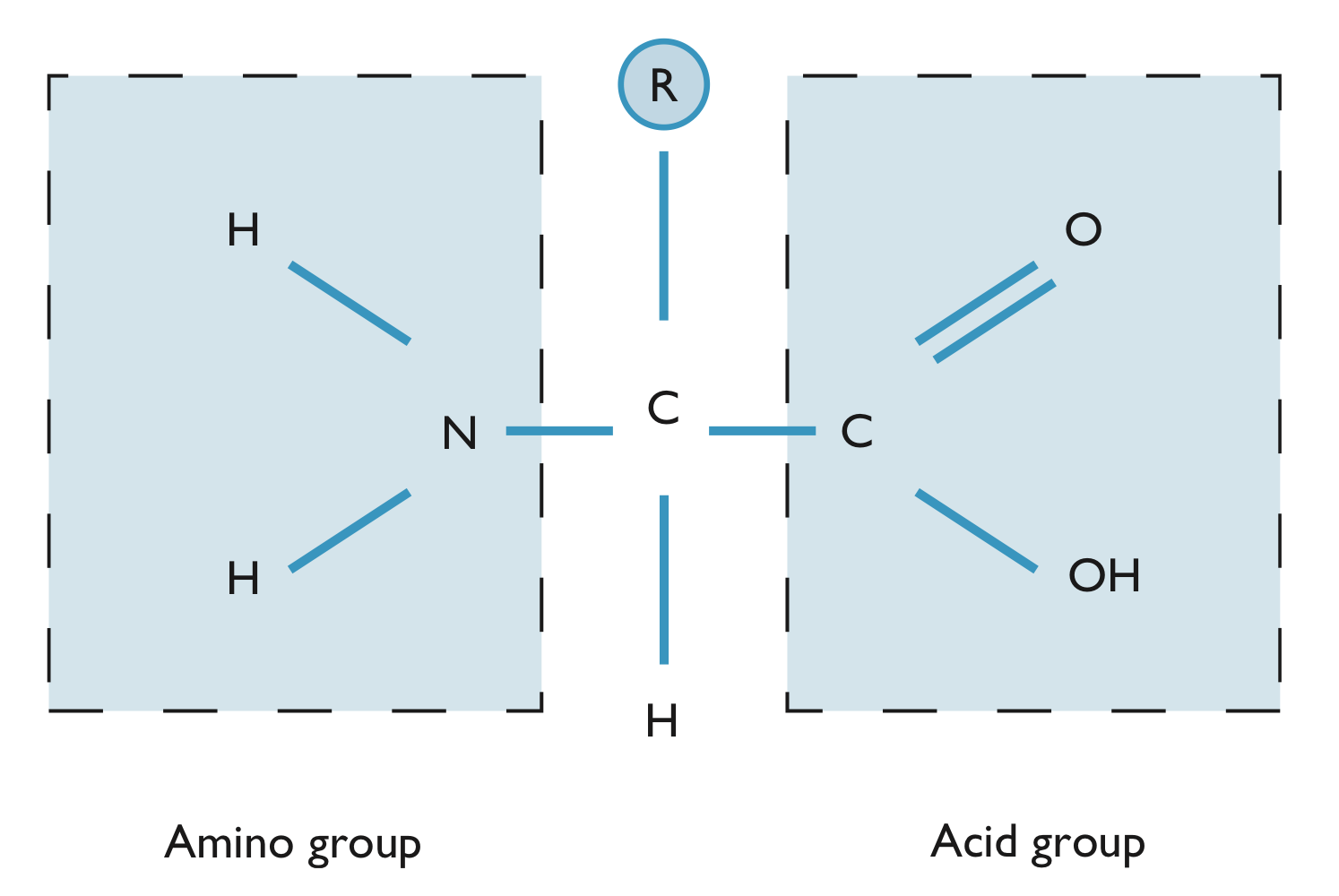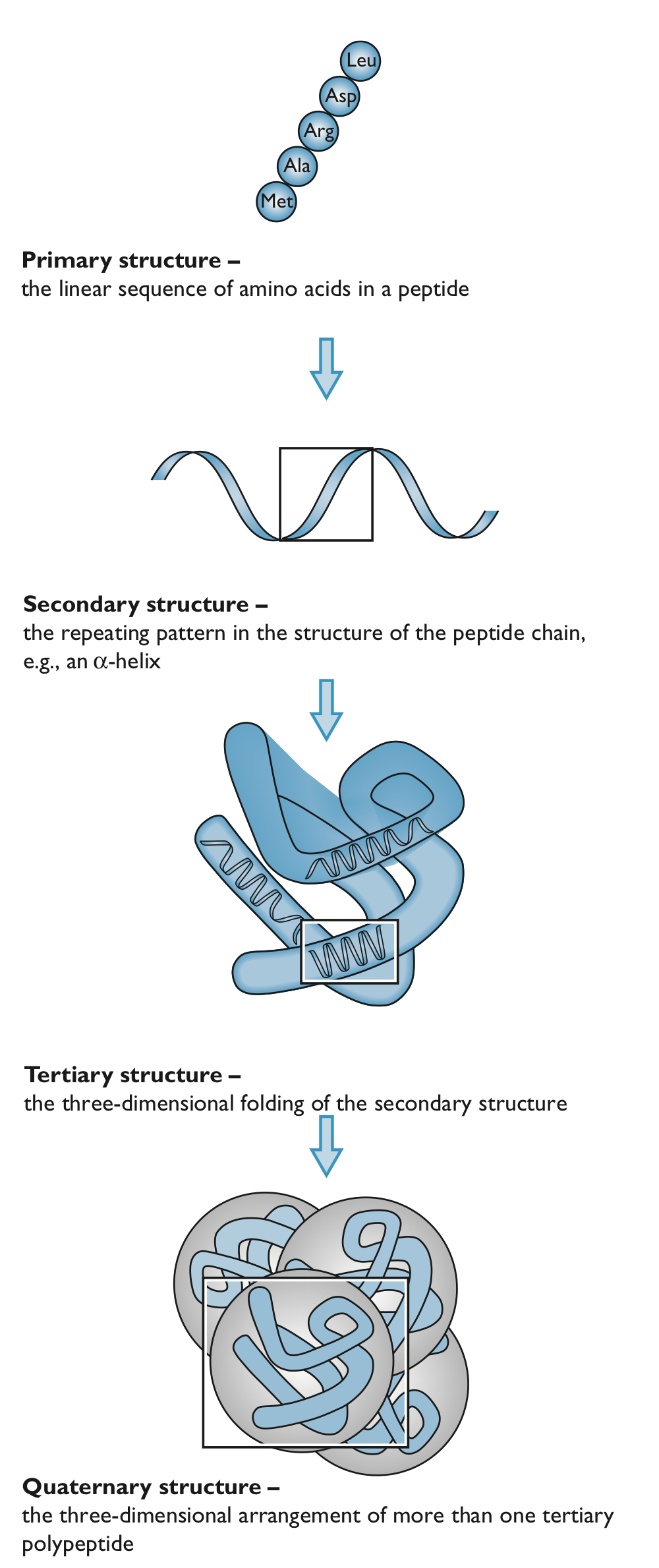Intro to Vet ANAT&PHY | Sect 1: The Dog & Cat - Chap 1: Principles of Cell Biology
'Anatomy' and 'physiology' are scientific terminologies used to describe the study of the body’s structure and how it actually functions, respectively.
\
Animal Classification
A fundamental comprehension of the classification system used to group animals is essential for studying any aspect of biology, such as how the species fit into this classification system should also be understood.
- Classification is the way in which species are sorted into orderly groups according to how closely related the species are to one another in terms of their evolutionary history, structural resemblance, and behavioral similarity.
- The science of classification is known as taxonomy.
- Organisms that have certain basic features in common are grouped together into a kingdom.
- If an organism is multicellular, meaning it is composed of more than one cell, and obtains its food by ingestion it is placed in the animal kingdom instead of other kingdoms such as plants and fungi.
- The animal kingdom is then further subdivided, based upon similarities of organisms, into a hierarchical system.
- Most living organisms are identified by a genus and species. Classification is further narrow down until eventually a particular genus and species is reached.
- The method is known as the binomial system, invented by the Swedish scientist Carl Linnaeus, where each plant or animal is known by two names.
- The first, defining the group within which it has natural affinities, is its genus.
- The second, including only those creatures with which it can interbreed, is its species.
\
In the animal kingdom, all species are divided into two groups: those with backbones, known as vertebrates, and those without backbones, known as invertebrates.
- The vertebrates are divided into eight classes. The subjects with the greatest veterinary relevance are:
- Amphibia - approximately 3080 species
- Reptilia - approximately 6600 species
- Aves or birds - approximately 8500 species
- Fish - approximately 30,000 species
- Mammalia - approximately 4070 species
These classes are then further divided into orders, and so on, until a species is identified.
\
The production of milk by the mammary glands and the possession of hair as a body covering are the distinctive features of mammals.
- Examples of mammalian orders include:
- Insectivores (e.g. shrews, moles)
- Rodents (e.g. mice, rat)
- Lagomorphs (e.g. rabbits, hares)
- Carnivores (e.g. cats, dogs, bears, seals)
- Ungulates (e.g. cows, sheep, horses)
- Cetaceans (e.g. whales, dolphins)
- Primates (e.g. monkeys, apes)
\
In terms of anatomy and physiology, all mammals share a similar basic structure, but each species has undergone adaptations to fit its unique lifestyle.
- Mammals have developed specializations for tasks like running, digging, chewing, jumping, and consuming particular foods.
Classification of Domestic Dog and Cat
| Taxonomic Group | Dog | Cat |
|---|---|---|
| Kingdom | Animal | Animal |
| Phylum | Chordata (vertebrate) | Chordata (vertebrate) |
| Class | Mammalia (mammal) | Mammalia (mammal) |
| Order | Carnivora | Carnivora |
| Family | Canidae | Felidae |
| Genus | Canis | Felis |
| Species | familiaris | catus |
| Common Name | Domestic Dog | Domestic Cat |
Anatomical Definitions
It is important to understand the terms that are used to describe where structures lie in relation to one another.

| Term | Definition |
|---|---|
| Median Plane | Divides the body longitudinally into symmetrical right and left halves; can be described as ‘the line down the middle of the animal’ from nose to tail |
| Superficial | Near to the surface of the body |
| Deep | Closer to the center of the body |
| Cranial / anterior | Towards the front of the animal (i.e. towards the head) |
| Caudal / posterior | Towards the rear end or tail of the animal (i.e. away from the head) |
| Medial | Structures that lie towards or near the median plane (i.e. closer to the middle of the animal) |
| Lateral | Structures that lie towards the side of the animal (i.e. away from the median plane) |
| Dorsal | Towards or near the back or vertebral column of the animal and the corresponding surfaces of the head, neck and tail |
| Ventral | Towards or near the belly or lowermost surface of the body and corresponding surfaces of the head, neck and tail |
| Rostral | Towards the nose; used to describe the position of structures on the head |
| Proximal | Structures or part of the structure that lie close to the main mass of the body, (e.g. the ‘top’ of the limb that attaches to the body); this is also used to describe parts that lie near the origin of a structure |
| Distal | Structures of part of the structure that lie away from the main mass of the body or origin (e.g. the free end of the limb) |
| Palmar | The rear surface of the fore paw that bears the footpads; the opposite surface (i.e. the front surface of the paw) is the dorsal surface |
| Plantar | The rear surface of the hind paw that bears the footpads; the opposite surface (i.e. the front surface of the paw) is the dorsal surface |
\
The Basic Plan of the Body
The body is made up of several systems, each of which performs a specific function that allows the body to function properly. Depending on their function, these systems can be classified into one of three categories.
- Structural systems - provides the basic ‘framework’ and transport system for the body
- Coordinating systems - the control mechanisms of the body
- Visceral systems - includes all the basic functional systems that do the general duties for the body cavities: thoracic, abdominal and pelvic
Each system of the body is made up of a collection of specific types of tissue arranged as organs. Each tissue is composed of a specialized type of cell, also known as the smallest unit of the body.
Structural Systems
- Skeletal system - the supporting frame upon which the body is built, such as bones and joints
- Muscular system - the mechanism by which the bones, relating to skeletal muscles only, are moved to bring about locomotion
- Integument - the covering of the body, such as skin and hair
- Cardiovascular system - transports the blood around the body
Coordinating Systems
- Nervous system - carries information to and from the central ‘control station’ of the body, such as the brain; controls and monitors the internal and external environment of the body
- Endocrine system - controls the body’s functions via a communication system of chemical messengers of hormones
Visceral Systems
- Digestive system - responsible for taking in food and breaking it down to its basic components so that the body can utilize them
- Respiratory system - responsible for taking in oxygen and removing carbon dioxide
- Urinary system - responsible for eliminating waste and toxic substances from the body
- Reproductive system - responsible for producing offspring
The Mammalian Cell
The minuscule components of a tissue that can only be observed under a microscope are called cells.
- Cells can be considered to be the basic structural and functional unit of an organism as they perform many basic bodily functions like respiration, reproduction, and ingesting nutrients and excreting waste.
- The various components of the cell, particularly the organelles, which float within the cytoplasm of the cell, perform these and other functions.
\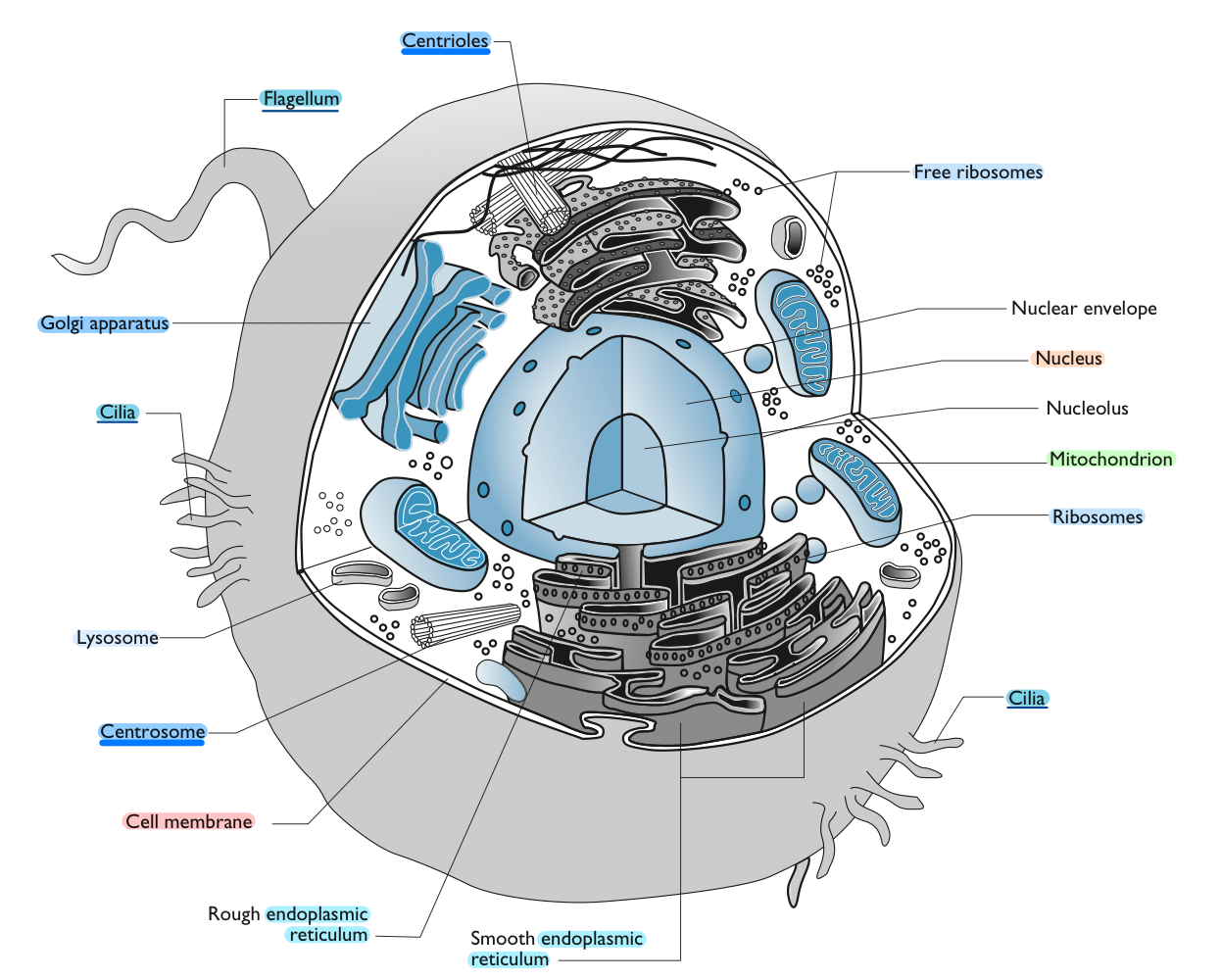
Cell Structures and Function
==Cell Membrane==
- The cell membrane, also called the plasma membrane, covers the surface of the cell and is responsible for separating the cell from its environment and controls the passage of substances in and out of the cell.
- Carbohydrates are found on the surface of the cell membrane and helps with cell recognition, thus enabling a cell to recognize whether a cell of the same type is in contact.
- The cell membrane of a mammalian cell is composed of a phospholipid bilayer, which is a double layer of phospholipid molecules with protein molecules embedded within it.
- Some substances can pass through the cell membrane because it is selectively permeable, but others may either be excluded or must cross the membrane using specialized transport systems due to its structure nature.
- Pores in the cell membrane - small molecules can pass through these pores
- Simple diffusion - molecules that are soluble in lipids, or fats, will passively dissolve in the lipid part of the cell membrane and diffuse across it; oxygen and water enter the cell this way
- Facilitated diffusion - another type of passive diffusion, where the substance is moving down a concentration gradient, but the substance enlists the help of a carrier protein to help it across the membrane; glucose uses this method to enter the cell
- Active transport mechanisms - substances are usually being moved from a region of low concentration to one of higher concentration, which requires energy as it is travelling against the concentration gradient. Substances that requires this method to cross the cell membrane use a carrier protein to transport them across. Since energy is required, it is supplied by the cell’s molecules of *adenosine **tri*phosphate, known as ATP; sodium enters the cell this way
Cytoplasm
- The fluid that fills the interior of the cell, providing it with support.
- The @@nucleus@@ and ^^organelles^^ are found within the cytoplasm, along with solutes such as glucose, proteins and ions.
@@Nucleus@@
- Surrounded by a nuclear membrane and contains the chromosomes, it is the information center of the cell.
- Chromosomes are the bearers of the hereditary material, DNA, which carries the information for protein synthesis.
- DNA is the ‘set of instruction’ that tells the cell how to function, and these instructions are then passed on to the cell’s descendants.
- The nucleus also contains several nucleoli, where ^^ribosomes^^ are manufactured.
^^Organelles^^
%%Mitochondria%% - responsible for cellular respiration and the site where energy is extracted from food substances and stored as ATP, a form of energy that the cell can use. When a cell requires energy it uses its store of ATP molecules.
<br />
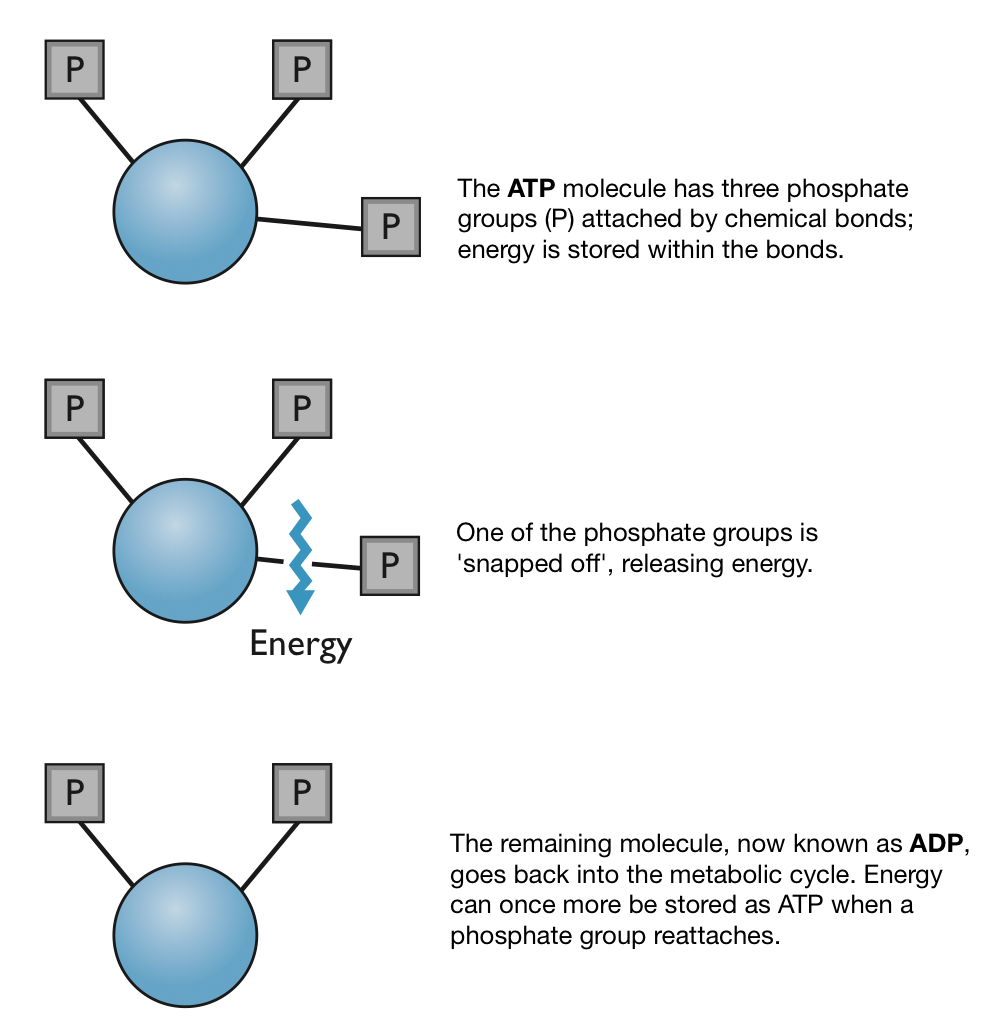
- The energy itself is stored in the bond that connects the phosphate group to the rest of the molecule, and if one of these phosphate groups is ‘snapped off’ the molecule, the bond is broken and energy is released.
- The remaining molecule is now called *adenosine **di*phosphate, ADP, because it now has only two phosphate groups attached to it.
- The cell needs only to re-attach another phosphate group, carried out as part of the cell’s metabolic processes, and energy can once again be stored as ATP.
- Have a smooth outer membrane and a highly folded inner membrane, which increases the surface area on which ATP production can take place.
- Is found in abundance in cells that are very active in terms of energy consumption, such as skeletal muscle.
^^Ribosomes^^ - these float free in the cytoplasm and are the site for protein synthesis within the cell.
^^Endoplasmic Reticulum^^ (ER) - a network of membrane-lined interconnected tubes and cavities within the cytoplasm of the cell.
- Rough ER - it has numerous ribosomes attached to its surface, giving it a rough appearance when viewed under a microscope.
- Its function is to transport the proteins that have been synthesized by ribosomes, and when some of these proteins are not required by the cell in which they are made, they are ‘exported’ outside the cell. Some examples are digestive enzymes and hormones.
- Smooth ER - does not have ribosomes on its surface.
- Its function include the synthesis and transport of lipids and steroids.
^^The Golgi Apparatus^^ - a stack of flattened sacs within the cytoplasm.
- Its function includes the modification of some of the proteins produced by the cell by adding a carbohydrate component, and plays a part in the formation of lysosomes.
Lysosomes - these are membrane-bound sacs that contain digestive enzymes, also known as lysozymes.
- Its function is to digest materials taken in by the cell during the process of phagocytosis or endocytosis. It also destroy worn-out organelles within the cell, and in some cases, the cell itself.
\
- Centrosome and Centrioles - the centrosome contains a pair of rod-link structures called centrioles.
- These lie at right angles to each other and are involved in cell division by the process of mitosis.
- Cilia and flagella - extensions of the plasma membrane seen on some cells of the body.
- Cilia are found in large numbers on the outer surface of the cells.
- Responsible for creating a wave-like motion that moves fluid such as mucus and debris over the cell surface.
- Flagella are usually single and longer than cilia and move the cell along by undulating movements.
- The only example of a flagellum in mammals is the tail of a spermatozoon.
Materials may be imported into the cell or exported from it. The terms endocytosis and exocytosis, respectively, are used to describe these processes.
- There are two types of endocytosis:
- Phagocytosis - ‘cell eating’
- Pinocytosis - ‘cell drinking’
- The process of phagocytosis is also used by some white blood cells to remove foreign particles such as invading bacteria.
Cell Division
The cells of the body is classified into two types:
- Somatic cells are all cells in the body that are not involved in reproduction. Somatic cells divide through mitosis and have a diploid number of chromosomes.
- The ova, within the ovaries, and spermatozoa, within the testes, are germ cells. Meiosis is the process by which germ cells divide and contain the haploid number of chromosomes.
Mitosis
Body tissues grow, especially when the animal is young, and can repair themselves when they are damaged. This is accomplished through the process of mitosis, in which the body's somatic cells make identical copies themselves.
The cells replicate by dividing into two, a process known as binary fission.
They must first duplicate all of the hereditary or genetic information that the new cell will require in order to function normally.
This information is stored in the deoxyribonucleic acid, known as DNA, of the chromosomes within the parent cell's nucleus.
The normal number of chromosomes is referred to as the diploid number, and the chromosomes are duplicated prior to cell division.
</p>
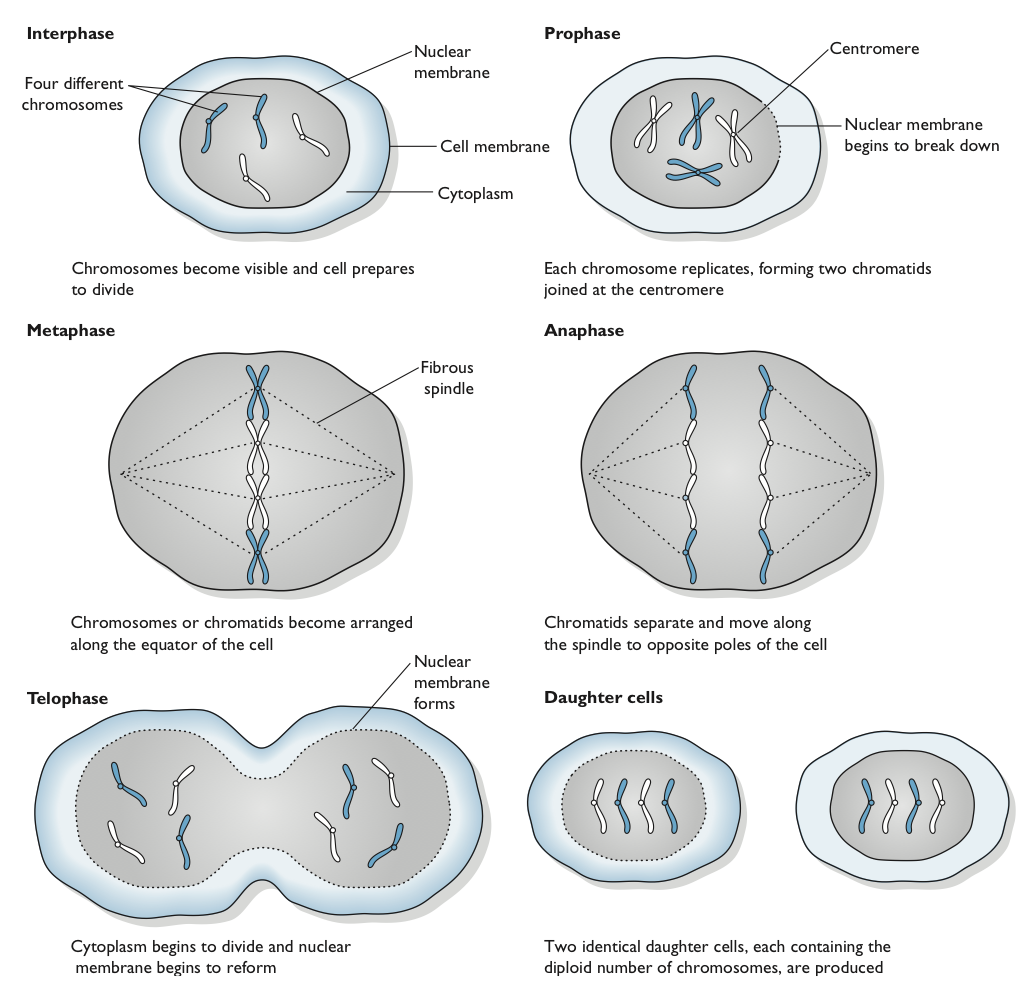
The process can be divided into four active stages, followed by a ‘resting’ stage, called interphase, during which the new daughter cells grow and prepare for the next division.
- Interphase is not actually a resting stage because this stage is when DNA replicates in preparation for the next mitosis. The centrioles have also replicated by the start of the new mitotic division.
Prophase - the nuclear membrane breaks down and the chromosomes contract and become shorter, fatter and more distinct. The identical pairs of chromosomes have not yet separated and are referred to as the chromatids.
- At a place known as the centromere, the chromatids are bound together. At this point, spindle fibers begin to form, and the centrioles are located at the polar opposites of the cells. These are 'threads' that are moving between the centrioles at the two poles.
Metaphase - the chromosomes line up in the middle of the cell, known as the equator, and the chromatids draw apart at the centromere.
Anaphase - the chromosomes attach to the spindle fibers and as these contract it moves the chromatids towards the opposite poles of the cell.
Telophase - the chromatids will be the chromosomes of the daughter cells.
- The spindle fibers break down and the nuclear membrane reforms.
- The cell starts to constrict across the middle and continues until it is divided into two.
- Each of the new daughter cells is genetically identical to the original parent cell, and both contain the full set of chromosomes, known as the diploid number.
- The chromosomes then unravel and the cell returns to interphase.
A mutation in cell division is called cancer. The cancerous, or neoplastic, cells have uncontrolled mitosis which results in a proliferation of cells forming a mass, also known as a tumor.
Meiosis
This is the process by which the germ cells divide within the ovary and the testis. It results in the production of ova or sperm containing half the normal number of chromosomes, known as the haploid number.
Meiosis must occur before fertilization, when a sperm penetrates the ovum and the two nuclei fuse.
- If those two nuclei had the diploid number of chromosomes then the nucleus of the resulting gamete would have twice the normal number and abnormalities would develop.
</p>
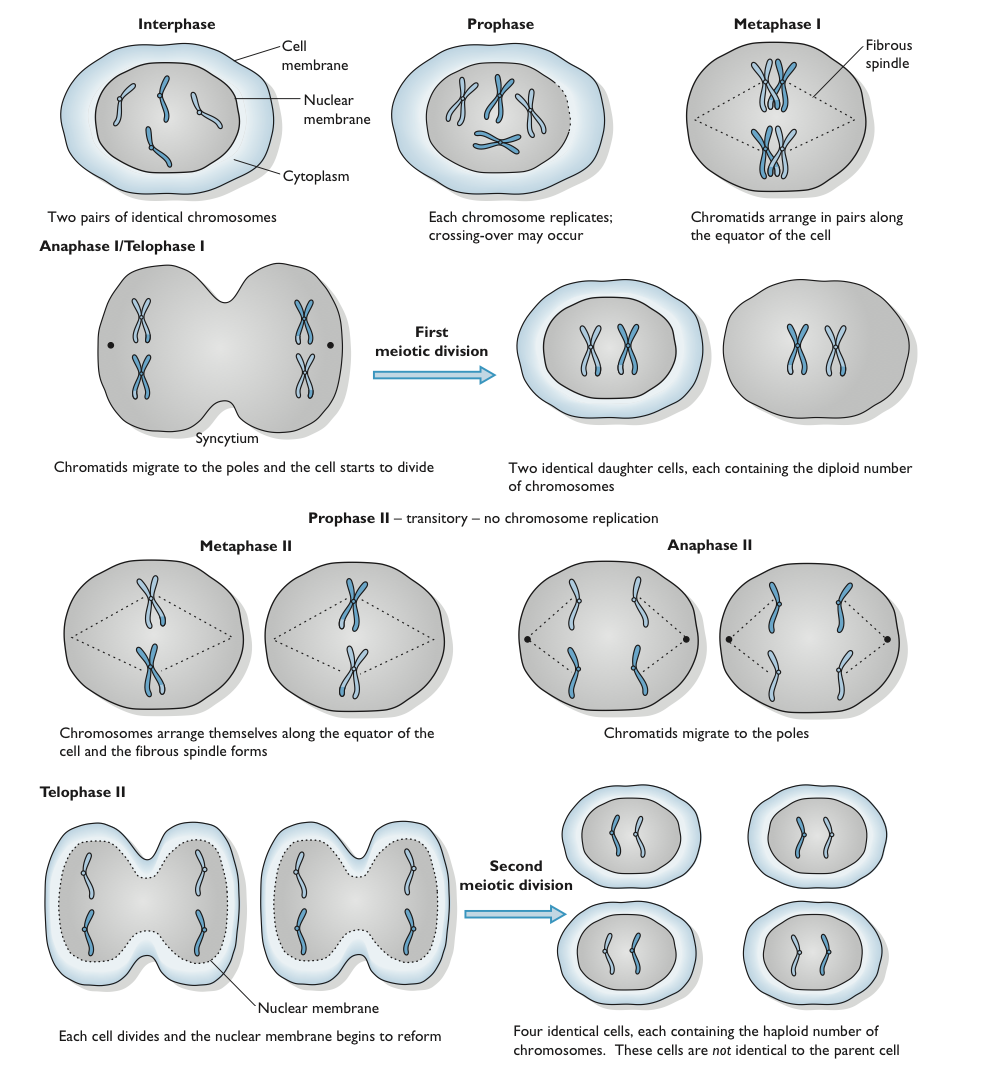
The resting cell is in interphase before meiosis begins. There are eight stages:
Prophase - this takes longer than prophase in mitosis.
- The identical, or homologous, chromosomes are arranged in pairs and duplicated; each pair is joined at the centromere.
- Because these chromosomes may become entangled and bits of one chromosome may become attached to another, a process known as ‘crossing over’ may affect the characteristics of the offspring.
Metaphase I - chromosome homologous pairs begin to align with the cell's equator during this process, and the fibrous spindle begins to take shape.
Anaphase I - the pairs separate and the chromatids migrate along the spindle fibers towards the poles of the cell.
Telophase I - the cytoplasm begins to divide but the nuclear membrane does not reform.
In some cells, syncytium occurs when the cytoplasm does not divide completely and a dumb-bell shaped cell is seen.
- Telophase I is the first meiotic division.
Prophase II - this may be transitory as there is no need to replicate the chromosomes.
Metaphase II - the chromosomes arrange themselves along the equator and the spindle fibers appear.
Anaphase II - the chromatids pull apart and migrate towards the poles of the cells.
Telophase II - the cytoplasm beings to divide, the nuclear membrane reforms and four identical daughter cells are formed.
- Telophase II is the second meiotic division.
\
An inherited condition - passed on to the offspring from one or both of the parents in their DNA.
Examples include progressive retinal atrophy, or PRA, which causes a degeneration of the retina in dogs.
- This results in blindness and a blood clotting disorder known as von Willebrand disease.
Both of these conditions can be genetically screened for before breeding the male and female dogs in order to prevent passing on these serious diseases to their puppies, because even though the dogs do not seem to be affected, they may still carry the gene.
</p>
A congenital condition - may have an inherited component but can also be as a result of an abnormality occurring during the development of the unborn puppy or kitten.
- This may be caused by a variety of factors, such as the mother contracting a virus while she was pregnant or the bitch or queen being undernourished.
The Chemistry of the Body
Chemicals make up the cells and, by extension, the tissues and organs, which are all made of cells. Understanding these chemicals and how they interact with one another inside the body is crucial.
- Two categories of chemical compounds exist:
- Organic compounds are those that contain the element carbon
- Inorganic compounds are all those compounds that do not contain carbon
Both groups are found in the body, but water - H₂O - are the most biologically important inorganic compound of the body.
Water Content of the Body
An individual mammalian cell contains ~ 80% water. In fact, 60 - 70% of the whole body’s weight is water, which is divided into two main body compartments of water:
- Intracellular Fluid (ICF) - takes up 40% of total body weight and is found inside the cells of the body and can be subdivided into the fluid within the blood cells and the fluid in all other cells.
- Extracellular Fluid (ECF) - lies outside the cells in the surrounding environment and takes up 20% of total body weight.
- It includes the fluid in which the blood cells are suspended - the plasma,
- the fluid within the lymphatic system and the cerebrospinal fluid - the transcellular fluid,
- and the fluid that surrounds all the other cells of the body - the interstitial or tissue fluid.
\
Plasma is rich in proteins, termed plasma proteins, which forms the medium in which the blood cells are transported within the blood-vascular system and takes up ~ 5% of body weight.
- Transcellular fluid is considered to take up ~1% of body weight and is formed by active secretory mechanisms so its volume varies.
- It includes fluids such as cerebrospinal fluid, digestive juices and lymph.
- Interstitial fluid is similar to plasma, but without the blood cells and protein molecules, takes up 15% of body weight and lies outside the blood vascular system, surrounding the cells. It serves as a medium in which the cells are bathed and from which they draw all the nutrients and oxygen they require while dumping all of their unwanted waste products into it.
- It is created from blood through the ultrafiltration process, which separates small molecules and ions from larger molecules and cells.
- The blood vascular system's pressure acts as a sieve, allowing everything but the large plasma protein molecules and the blood's cellular constituents to pass through while forcing the fluid through the capillaries' walls.
\
Water, or fluid, serves as the medium for all of the body's biochemical reactions, making it crucial to keep the internal environment of the body in balance, a process known as homeostasis.
\
The biological processes of diffusion and osmosis are in charge of the constant movement of the chemicals that make up body water in the body.
Diffusion
Defined as movement of molecules of a liquid or a gas down a concentration gradient, from a region of high concentration to a region of low concentration, continuing to occur until an equilibrium is reached.
It only occurs in situations where molecules or ions can move freely and is crucial for their movement into and out of cells, but it can only happen if the particles are small enough to pass through the cell membrane.
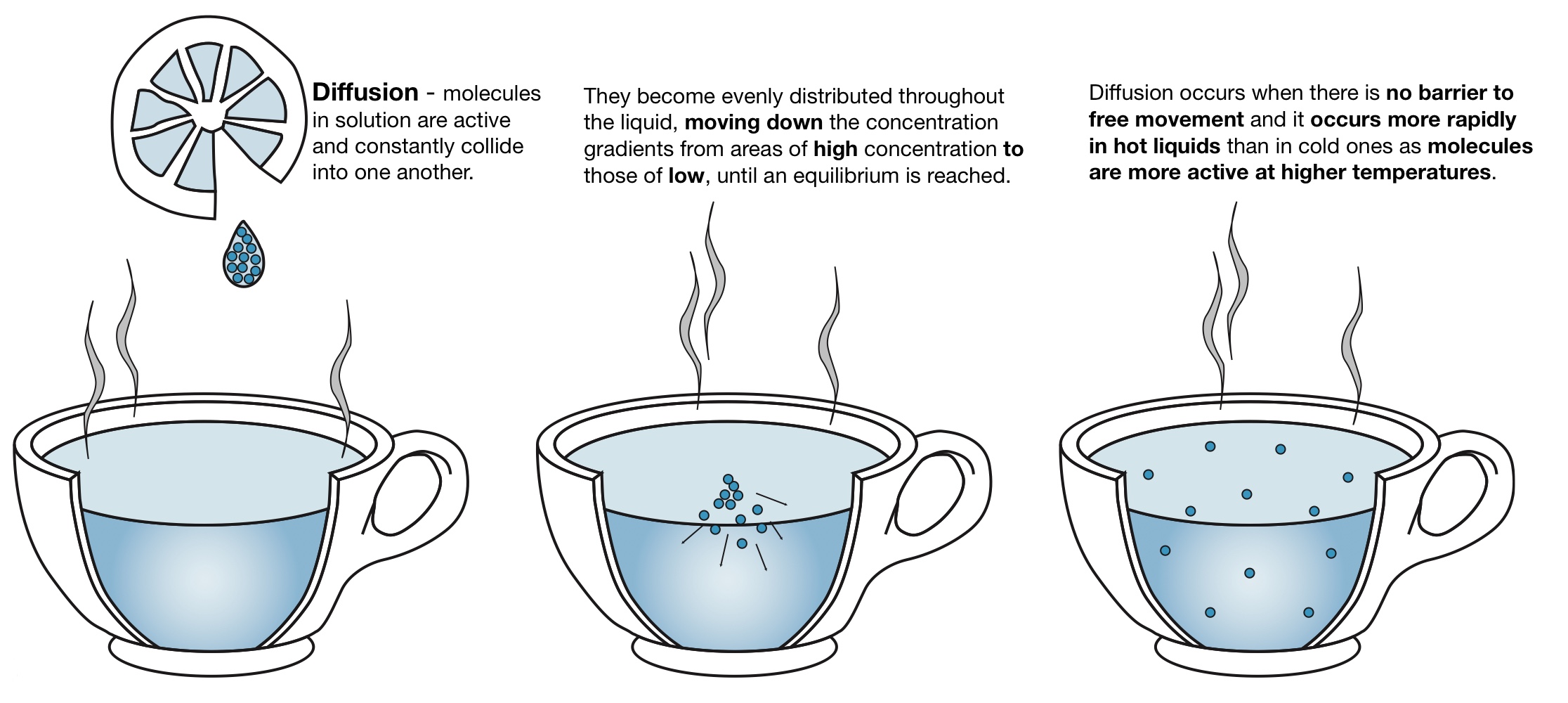
Osmosis
Defined as movement of water through a semi-permeable membrane which allows some substances through but not others, from a fluid of low concentration to one of a higher concentration. The water is diffused along a concentration gradient, continuing until the two concentrations are equal.
Responsible for water movement from the interstitial fluid into the cells.
A solution consists of the molecules of one substance, the solute, dissolved in another solution, the solvent.
- In the body, the solvent is water. Hence, osmosis is a significant factor in the maintenance of the fluid volume within the body fluid compartments.
A solution can be described as having an osmotic pressure.
- For example, if the osmotic pressure of the plasma is high, water will flow into the blood to equalize the concentration; if the osmotic pressure of the plasma is low, water will flow out of the blood into the tissue space. This pressure is required to prevent osmosis from occurring and depends on the number of particles, both dissolved and undissolved, in the solution.
- The osmotic pressure, or tonicity, of a rehydrating fluid is described relative to the osmotic pressure of blood plasma as follows:
- Isotonic - fluid has the same osmotic pressure as plasma
- Hypotonic - fluid has a lower osmotic pressure than plasma
- Hypertonic - fluid has a higher osmotic pressure than plasma
- When choosing fluids for rehydration therapy, isotonic fluids are typically used because the replacement fluid must be as similar in tonicity and electrolyte content to that which has been lost from the body.
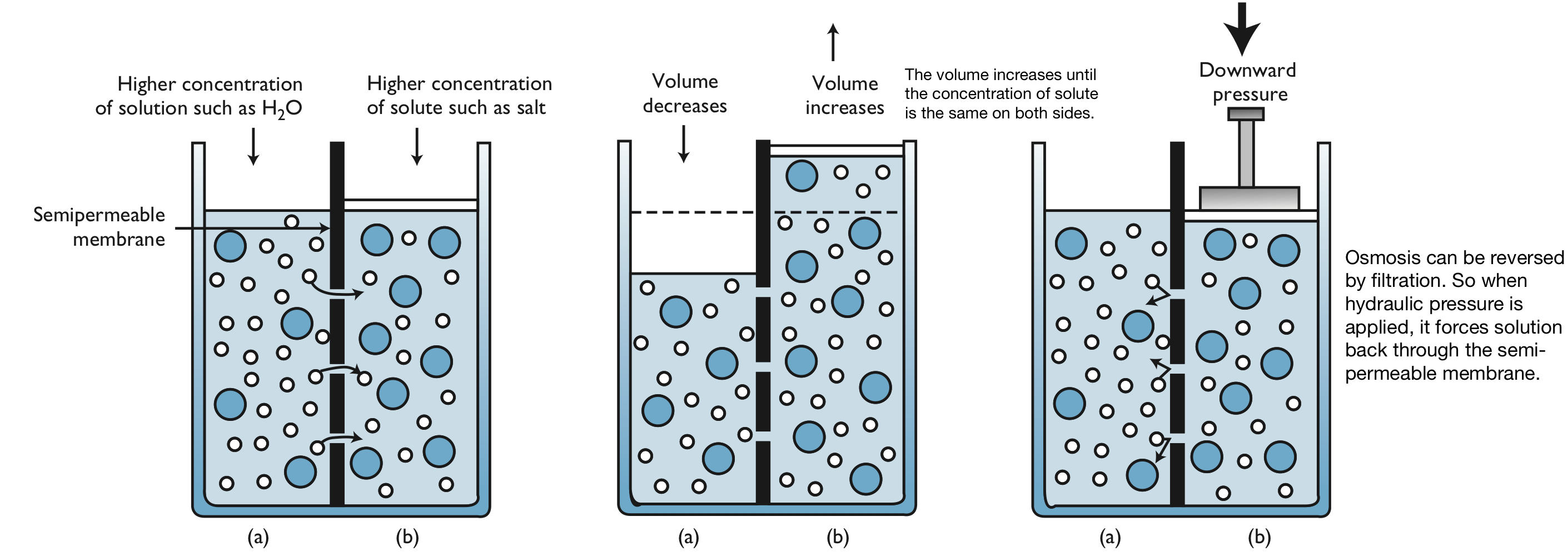
Fluid Balance
Fluid balance in the body means that the input and output of fluids in the body must be equal to allow the body to function properly, and is obtained through ingesting liquids or by consuming food that contains water. 60% of an adult animal's weight is made up of water. This proportion will be slightly higher in young or thin animals, and slightly lower in old or extremely obese animals as fatty tissue contains little water.
\
Water is constantly moving within the body, such as the plasma to the tissue fluid, but it is also continuously excreted from the body in the following ways:
- Respiration, as expelled air contains water vapor
- Urine and feces
- Panting, to get rid of excess body heat
- Vaginal secretions
- Tears, which are continuously produced to moisten the eye
\
Fluid losses may be increased in sick or injured animals in such ways:
- Vomiting
- Diarrhea
- Vaginal discharge, as seen with an open pyometra
- Blood loss
\
This may lead to dehydration resulting in serious consequences such as reduction of the circulating blood volume, known as hypovolemic shock.
\
Inorganic Compounds
Minerals, acids and bases are some of the inorganic compounds that are essential to the functions of the body.
- Everything is composed of atoms
- An element is a substance that is composed of only one kind of atom
- Such as the element oxygen consists only of oxygen atom
- Molecules consist of two or more atoms linked by a chemical bond
- A substance whose molecules contain more than one type of atom is called a compound
- When dissolved in water, the molecules of many substances break apart into charged particles, called ions
- Ions with one or more positive charge are called cations
- Ions with one or more negative charge are called anions
- An electrolyte is a chemical substance that, when dissolved in water, splits into ions and is thus capable of conducting an electric current
- Sodium chloride (NaCl) is an example of an electrolyte in the body
- Its ions being sodium (Na+) and chloride (Cl-) in solution
Minerals
The principal cations in the body are sodium (Na+), potassium (K+) , calcium (Ca2+) and magnesium (Mg2+), while the principal anions include chloride (Cl-) and bicarbonate (HCO3-).
- These ions are necessary for the body's functions and must be present in sufficient and balanced amounts.
- The concentration is important in the regulation of fluid balance between the ICF and ECF, and is maintained by special ‘pumps’ in the cell membrane.
- An imbalance will lead to significant problems such as:
- Sodium affects the osmotic pressure of the blood, therefore, influences blood volume and pressure
- A high concentration of potassium in the ECF can disrupt heart function
\
Important minerals such as calcium, phosphorus, and magnesium are stored in bone tissue.
- Calcium is essential for many processes in the body such as:
- Muscle contraction
- Nerve conduction
- Blood clotting
- Iron and copper are also essential, as iron is a component of hemoglobin in red blood cells.
Acids and Bases
- An acid is a compound that can release hydrogen ions when dissolved in solution.
- Compounds that can accept or take in hydrogen ions are called bases or alkalis.
The pH of a solution, which measures the concentration of hydrogen ions, is used to express its acidity.
- The pH scale ranges from 0 to 14, with 7 being neutral.
- A solution with a pH less than 7 is acidic
- The lower the number, the higher the acidity as the concentration of hydrogen ions is greater
- A solution with a pH above 7 is basic, or alkaline
- The higher the number, the more alkaline the solution is
\
Homeostatic processes maintain the correct acid/base balance within the respiratory system and kidneys to keep the pH levels of body fluids in check. Any disruption of the normal pH of the body may lead to:
- Acidosis, which may occur when the animal has a decreased blood pH
- Respiratory acidosis may develop if the animal holds its breath, allowing carbon dioxide levels rise and oxygen levels to fall
- Metabolic acidosis may occur as a complication of diabetes mellitus
- Alkalosis, which may occur when the animal has a increased blood pH
- Respiratory alkalosis occurs during rapid panting, which lowers carbon dioxide levels.
- Metabolic alkalosis is a result of excessive vomiting and diarrhoea
Organic Compounds
Compounds that are based on the element carbon are called organic compounds.
- Oxygen, hydrogen, and in some instances, nitrogen are other main elements found.
- The principal organic compounds found in the body are carbohydrates, proteins and fats.
Carbohydrates
Carbohydrates, also known as sugars, are obtained from food which are then broken down during digestion into simple sugars that can be absorbed through the mucous membrane of the digestive system into the blood and utilized as an important source of energy.
It contains carbon, hydrogen and oxygen.
Glucose is the most common simple sugar in the body.
The simple sugars form the foundation of more complex carbohydrates known as polysaccharides, which consist of many sugars linked together to form extensive chains of sugars.
Glycogen is an example of energy stored in the body by animals, which consists of more highly branched chains of glucose.
</p>

Lipids
Lipids include the fats, which are compounds of fatty acids and glycerol.
It is also made up of carbon, hydrogen and oxygen.
Fatty acids are the main form in which fats are transported in the blood after the breakdown of lipids obtained from food.
Fats are an important means of energy storage for the body as it can also yield a large amount of energy to be used when required.
- Other functions of lipids include insulation of the body itself and of nerves, and in the formation of cell membranes and synthesis of steroids.
</p>
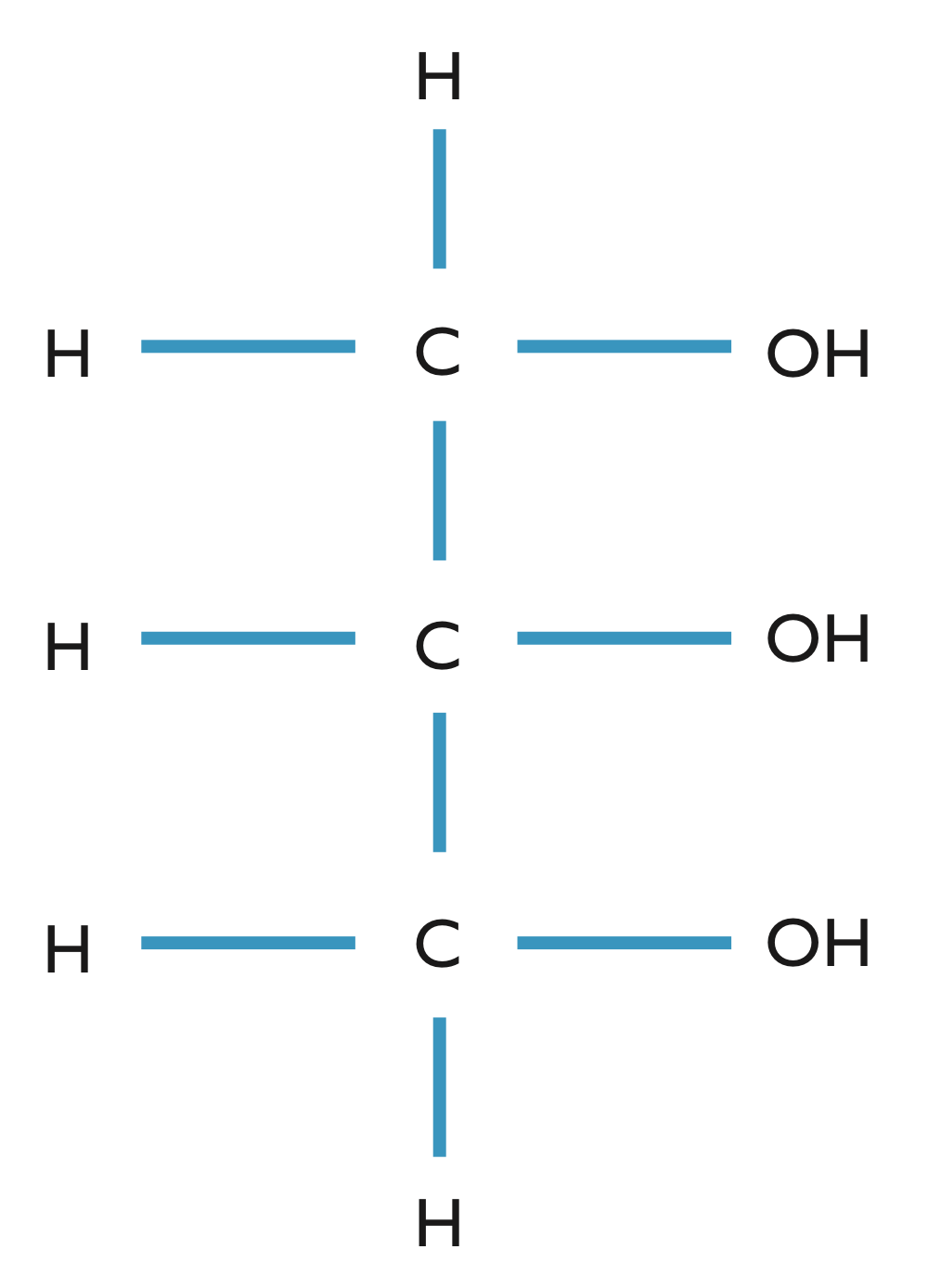
Proteins
Proteins are built up from subunits called amino acids.
- In addition to being made up of carbon, hydrogen and oxygen like carbohydrates and lipids, proteins always contain nitrogen as well and may also contain other elements such as sulphur, phosphorus and iodine.
- A dipeptide is formed when two amino acids are joined together by a peptide link.
\